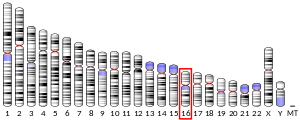From Wikipedia, the free encyclopedia
Protein-coding gene in the species Homo sapiens
Protein kinase C beta type is an enzyme that in humans is encoded by the PRKCB gene .[ 5]
Protein kinase C (PKC) is a family of serine - and threonine -specific protein kinases that can be activated by calcium and second messenger diacylglycerol . PKC family members phosphorylate a wide variety of protein targets and are known to be involved in diverse cellular signaling pathways. PKC family members also serve as major receptors for phorbol esters , a class of tumor promoters . Each member of the PKC family has a specific expression profile and is believed to play a distinct role in cells . The protein encoded by this gene is one of the PKC family members. This protein kinase has been reported to be involved in many different cellular functions, such as B cell activation, apoptosis induction, endothelial cell proliferation , and intestinal sugar absorption. Studies in mice also suggest that this kinase may also regulate neuronal functions and correlate fear-induced conflict behavior after stress. Alternatively spliced transcript variants encoding distinct isoforms have been reported.[ 6] autism .[ 7] [ 8]
PRKCB1 has been shown to interact with RIPK4 ,[ 9] beta adrenergic receptor kinase ,[ 10] PDLIM5 [ 11] GNB2L1 .[ 12]
^ Jump up to: a b c GRCh38: Ensembl release 89: ENSG00000166501 – Ensembl , May 2017^ Jump up to: a b c GRCm38: Ensembl release 89: ENSMUSG00000052889 – Ensembl , May 2017^ "Human PubMed Reference:" . National Center for Biotechnology Information, U.S. National Library of Medicine .^ "Mouse PubMed Reference:" . National Center for Biotechnology Information, U.S. National Library of Medicine .^ Kubo K, Ohno S, Suzuki K (September 1987). "Nucleotide sequence of the 3' portion of a human gene for protein kinase C beta I/beta II" . Nucleic Acids Research . 15 (17): 7179– 80. doi :10.1093/nar/15.17.7179 . PMC 306204 PMID 3658678 . ^ "Entrez Gene: PRKCB1 protein kinase C, beta 1" .^ Philippi A, Roschmann E, Tores F, Lindenbaum P, Benajou A, Germain-Leclerc L, et al. (October 2005). "Haplotypes in the gene encoding protein kinase c-beta (PRKCB1) on chromosome 16 are associated with autism" . Molecular Psychiatry . 10 (10): 950– 60. doi :10.1038/sj.mp.4001704 PMID 16027742 . ^ Lintas C, Sacco R, Garbett K, Mirnics K, Militerni R, Bravaccio C, et al. (July 2009). "Involvement of the PRKCB1 gene in autistic disorder: significant genetic association and reduced neocortical gene expression" . Molecular Psychiatry . 14 (7): 705– 18. doi :10.1038/mp.2008.21 PMID 18317465 . ^ Chen L, Haider K, Ponda M, Cariappa A, Rowitch D, Pillai S (June 2001). "Protein kinase C-associated kinase (PKK), a novel membrane-associated, ankyrin repeat-containing protein kinase" . The Journal of Biological Chemistry . 276 (24): 21737– 44. doi :10.1074/jbc.M008069200 PMID 11278382 . ^ Yang XL, Zhang YL, Lai ZS, Xing FY, Liu YH (April 2003). "Pleckstrin homology domain of G protein-coupled receptor kinase-2 binds to PKC and affects the activity of PKC kinase" . World Journal of Gastroenterology . 9 (4): 800– 3. doi :10.3748/wjg.v9.i4.800 PMC 4611453 PMID 12679936 . ^ Kuroda S, Tokunaga C, Kiyohara Y, Higuchi O, Konishi H, Mizuno K, et al. (December 1996). "Protein-protein interaction of zinc finger LIM domains with protein kinase C" . The Journal of Biological Chemistry . 271 (49): 31029– 32. doi :10.1074/jbc.271.49.31029 PMID 8940095 . ^ Ron D, Jiang Z, Yao L, Vagts A, Diamond I, Gordon A (September 1999). "Coordinated movement of RACK1 with activated betaIIPKC" . The Journal of Biological Chemistry . 274 (38): 27039– 46. doi :10.1074/jbc.274.38.27039 PMID 10480917 .
show Activity Regulation Classification Kinetics Types







